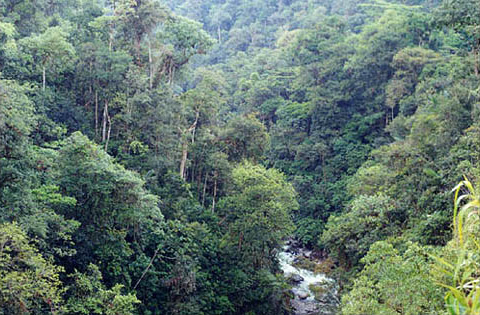This is the latest volume of Ecological Studies, a
continuing series of technical monographs on various ecology-related topics,
which began publication already in 1973. The publisher is German, but the books
are in English (with the occasional error in grammar or vocabulary).
"Ecosystem Services, Biodiversity and Environmental Change in a Tropical Mountain Ecosystem of South Ecuador" is a meticulously detailed case study of environmental degradation in southern Ecuador. The research area is situated at the border of the Podocarpus National Park, in the San Francisco Valley. Both German and Ecuadorean scientists have been involved, and the book even contains old maps of the area made in the DDR!
The local inhabitants of the region are diverse: both Native groups and Mestizos (the Spanish-speaking majority population). The Andes of southern Ecuador are a hotspot of biodiversity, especially of vascular plants and birds. Thus, there are 280 species of trees and 337 species of orchids in the river valley. 98 species of moss have been recorded on one single tree! In the research area itself (christened RU 816), which only covers 11 square kilometres, a whopping 2,400 species of moths have been found, an almost absurd world record of some sort.
Unfortunately, southern Ecuador is also the area in South America with the largest rate of deforestation. Road construction, population pressure and economic development (including cash crops and oil extraction) are some of the reasons. An agrarian reform law adopted in 1964 and subsequent colonization of previously pristine state lands is another factor. The population in RU 816 grow food for subsistence, and raise cattle for sale on the market. They also make extensive use of the surrounding forests. Land destruction is common: an area is burned for pasture, overgrazing makes the pastures vulnerable to aggressive weeds, and the pastures and then abandoned. Unfortunately, the natural forests never return. The research team believe that the rearing of cattle in the San Francisco Valley is neither sustainable, nor sufficiently profitable for the local inhabitants themselves. In general, human land use is the biggest threat to biodiversity in Ecuador, with climate change relegated to second position.
"Ecosystem Services, etc" contain a number of technical papers on the ins and outs of everything from soil quality (including the presence of testate amoebae and oribatid mites), landslides, different kinds of pastures, the future effects of climate change, and possible solutions to the predicament. The researchers strike a positive pose, claiming that reforestation and local economic development can be combined. I can imagine what the Ecuadorean government might have done to their grants, had they claimed something else! Well, let's hope the RU 816 team is right. One problematic aspect of the papers included in this volume is the somewhat nebulous term "ecosystem services", found already in the book title. Several chapters suggest that one such "service" is the interest a certain area might have for scientists! Really?
Frankly, most of this book is somewhat over my head, so I mostly skimmed it. That being said, I don't doubt that this is a competent case study of an ecologically important area. Of course, if you are a budding ecologist, chances are you can't afford to buy this book! I mean, 179 dollars?
Hopefully available at a university library near you. ;-)

No comments:
Post a Comment